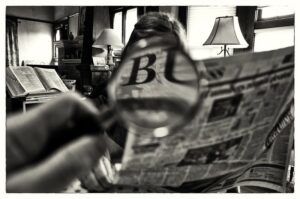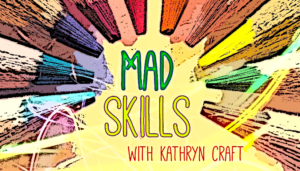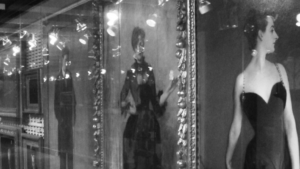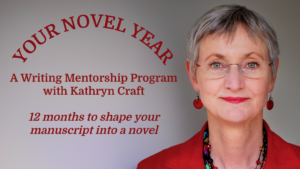Inspirations
Planet Word Museum, housed in the historic Franklin School of Washington, DC – Spring 2022
Some days we need a little inspiration. And, truth be told, sometimes we need a lot.
The current times fall into the latter, at least for me and likely for many of you as well. But when individuals and families a continent away are calling out for food, shelter and salvation during a brutal new war, it can feel selfish to seek amusement or simple joys. And even when we do, it can be hard to immerse yourself, to truly benefit from the experience.
Fortunately, I recently stumbled upon a magical place in downtown DC that somehow evaded my stifling instincts. That place is Planet Word, an innovative DC museum on a mission to nurture a love of words, language and reading. My visit there proved a worthy diversion, reawakening a sense of childhood wonder. The concept and execution so impressed me that I immediately wanted to share it with you all, my writing clan. So please sit back and allow me to take you on a virtual visit to the nation’s first and only museum devoted to the power of words.
An Innovative Museum in a Historic Setting
Planet Word feels special from the moment you enter the grounds. An eye-catching canopy sculpture reminiscent of a weeping willow greets you – literally – as you amble through the courtyard to the main entrance. Contemporary artist Rafael Lozano-Hemmer’s aptly named Speaking Willow consists of dozens of dazzling concave speakers dangling from artificial branches, each lighting up while voicing a song, saying or poem in one of over 400 languages when activated by motion below. The small gathering on the morning of my visit provoked quite the cacophony as we passed beneath it, as if we had disturbed a flock of slumbering birds. The effect is hypnotic, nudging visitors to open their ears and their minds before stepping inside.
Read More“I work everywhere, but I work best here.”
– Tennessee Williams (of his time in Key West)
Something mysterious happens to writers when they visit Key West. They tend to fall in love with the place and never want to leave.
Take novelist Ernest Hemingway. He and his wife, Pauline, arrived on an ocean liner from Paris, by way of Cuba, in 1928. As the story goes, they had been planning to pick up a new car they’d ordered and drive North. But when the car was delayed for several weeks, stranding them in paradise, they rented a room at the Trev-Mor Hotel and soon fell captive to the island’s charms, making Key West their home for over a decade. Eventually they purchased their famous Spanish Colonial style house on Whitehead Street, where Hemingway wrote A Farewell to Arms, Death in the Afternoon, and Winner Takes Nothing, among others.
Playwright Tennessee Williams first vacationed in Key West in 1941, often staying at La Concha Hotel, where he finished writing A Streetcar Named Desire. Eight years later, he purchased a home on Duncan Street and created a writing studio he named “the Mad House,” where he wrote and painted until his death in 1983.
Singer, songwriter, and author Jimmy Buffett first arrived in Key West in 1971 to heal a broken heart caused by the end of his first marriage and the rejection he’d encountered in Nashville. He remained a resident for 30 years, during which time he found his tropical sound and wrote the lyrics to the song that catapulted his career, “Margaritaville,” as well as three best-selling books.
Novelist Judy Blume first arrived in Key West in the mid-1990s to escape the harsh New York City winter and finish her adult novel, Summer Sisters. She and her husband fell in love with the island and made it their home for the next 25 years. Novelist Meg Cabot and her husband share a similar Manhattan-to-Key-West story, becoming residents in 2005, where she has continued penning The Princess Diaries series as well as children’s novels, young adult novels, a manga series, and more.
With warm winters, palm-tree-lined streets, and electric blue water, it’s easy to understand what attracts writers to Key West. But what compels them to stay?
Maybe it’s the opportunity to live a simpler life—one where you can start your morning with a walk on the beach, like Robert Frost, who wintered in Key West from 1945-1960, where you can catch your dinner, like Hemingway, who spent his free time fishing, and where you can travel anywhere you need to go by bicycle. Perhaps it’s the uplifting effect of near-constant sunshine on the melancholic creative mind. Or maybe it’s as simple as Tennessee Williams once put it, “it’s the only place in this country where it’s warm enough to swim every day of the year.”
Spend a little time in Key West, and you too may begin to feel its seductive pull for once you look past its obvious paradisal patina, you’ll find interesting people, tales of triumph and defeat, and an enchanting history that’s often stranger than the fiction written there.
Whether you have three days or three decades to explore, Key West is the perfect place […]
Read More
Like many people around the world, I’ve been watching Peter Jackson’s documentary The Beatles: Get Back. Notice I said, “I’ve been,” as in, “I have been,” as in…well, I haven’t finished the thing yet.
Immediately upon starting the first of the documentary’s three installments, I decided that I was going to take my time with it. As easy as it’d be to succumb to my pandemic-era urge to binge straight through, I’m very much aware that this is a one-shot deal. More than fifty years have gone by since the documentary’s footage was originally filmed. Two of the Beatles are no longer with us. The two who are are 81 and 79 years old respectively. In other words: I doubt there will be a sequel.
What I have seen so far, though, has been incredible. Full disclosure: my love for the Beatles is endless. Their portraits from the White Album hang over my desk as I write this, I named my late corgi Ringo, and my fourth novel, All Together Now, was inspired by one of their songs. So, please indulge me for a moment as I speak strictly as a fan.
BLATHERING ABOUT THE BEATLES
Seeing them together at the height of their powers—the footage treated and restored to HD quality—has been a surprisingly emotional experience, like what I imagine traveling back in time and visiting younger versions of loved ones would feel like. As culturally significant as I know the Beatles to be, the documentary also shows them as funny and silly and easily distracted, particularly Ringo. John was constantly late to work, but charmingly so. George seemed to be in a perpetual state of vulnerability, not quite sure where he fit in. And for Paul, the task of being the de facto “boss” of the Beatles weighed heavily. I also appreciated the warmth on display between Yoko Ono and Linda McCartney. As the two women huddled together laughing while the band jammed out in the background, I found that I had to take a few deep breaths.
“Daddy, are you crying?” my daughter asked.
“What? No. Well, maybe a little.”
BLATHERING ABOUT WRITING
Speaking now as a writer, The Beatles: Get Back offers a startlingly raw behind-the-scenes look at the slow, emotionally painful process of creating art. In one scene, George, clearly nervous, asks Paul if he’d like to hear a song that he wrote the night before. George then sits and plays a rough, acoustic version of “I Me Mine.” (Yes, I got chills.) In another scene, after many, many failures to launch, the song “Let It Be” finally takes flight. It begins with Paul at the piano. The other three look on, fiddling with their instruments. And then the energy shifts in the room, and we watch as John, Paul, George, and Ringo work together furiously to hold one of the most famous songs of the Twentieth Century together. (And, yes, I may have cried a little again.)
I was struck by both moments, because they illustrate something that I’d never really thought about as it pertains to the Beatles. Even for them—perhaps especially for them—the work was really hard.
CREATING ART IS DIFFICULT
That may be the most obvious subhead I’ve ever written, but it’s something that needs to be stated—and […]
Read MoreNewspaper articles, extracts from books, diary entries, audio transcripts, records of phone calls, email chains, text messages, social media posts: all of these and more can be and are used in novels to advance, enhance and extend the story. Supporting the ‘traditional’ narrative, these other forms can allow authors to embed information in a way that doesn’t burden the main narrative, which is especially useful when the novel is based on factual events. They can also provide a way to run parallel narratives or to provide alternative points of view on what is going on. Most of all they allow authors to create a richly-textured story-world with many varied strands to its narrative tapestry.
There are popular novels that ditch the traditional narrative form entirely, concentrating purely on those ‘other’ forms of telling the story. Two examples that spring to mind are Amie Kaufman and Jay Kristoff’s YA speculative fiction series, The Illuminae Files, which uses a variety of forms, from military files to emails, interviews to medical reports, to tell the story, and Janice Hallett’s crime novel, The Twyford Code, which is told entirely through transcripts of audio files from an old iPhone, including recorded phone calls. These books manage to create a satisfying and engaging story world, and make readers care about their characters without using traditional narrative forms at all. In this piece I’ll concentrate more on inserting those ‘other’ narrative forms into traditional narrative in order to enrich the texture of a novel. The most important thing to remember is that you need a real reason to use these different forms: they shouldn’t just be there because they can be. Of course, you should have fun with them too: but they need to feel like they really belong in your story.
I’ve always enjoyed using different narrative forms in my books and have used these extensively over the years. For example, in The Ghost Squad, a YA speculative fiction thriller published last year, I used extracts from contraband pamphlets, secret reports, extracts of unpublished manuscripts, and more, whilst also running a traditional narrative but told through two different points of view. In other novels, I’ve created short newspaper articles, notebook extracts, blog posts, transcripts of phone calls, emails, text messages and more, to extend and enrich the narrative and also sometimes provide factual information that might otherwise interrupt the story. It’s an enjoyable process, even if challenging at times!
So what have I learned over those years of using different narrative forms to tell a story? Aside from the key point I mentioned earlier, about having a real reason for integrating them, my advice is:
Read More
I basically live in a tree house, where I’m tucked in a cove on the side of a mountain with more trees on my lot that probably anyone else in the Cove. There’s a lot of wildlife that lives in and around trees and I certainly have my share, which I love and appreciate and respect.
Except. There’s this one squirrel.
Squirrel and I have been doing a dance for months in its relentless quest for what it desires. Squirrel wants something from me, and it will not tire in its pursuit to convince me I should give it what it wants because Squirrel is tenacious—and tenacity and never giving up always wins, right? We’ll see about that.
Now, I’m not a squirrel hater in general. Most squirrels do their thang and even benefit the forest by burying nuts that will grow to more trees, or while unintentional on the squirrel’s part, will feed other foraging animals when food is scarce. They’re relatively intelligent, excellent swimmers, very agile, and can even be cute.
Like a lot of critters, squirrels don’t see obstacles in the way humans do and are fearless in protecting what’s theirs—I very much admire that! Humans can also be single-mindedly stubborn in the pursuit of Their Dreams. But humans, unlike most animals, feel Everlasting Hope (sometimes Everlasting Despair but that’s another essay for another day) even when Everlasting Hope, like fate and love and religion, is, well, screwy and fickle and unreliable.
Squirrels are wily in their hope, born out of instinct for survival, mixed with a bit of assholeyness.
Squirrels think: “Food. Need food. Want food. Food here once; food here again. If Threat Woman tries take food, me hurry-grab small piece and flick tail (squirrel’s human equivalent of The Finger). Me know she later put back food—maybe for birds, but me think maybe for me, only need to show up again and again and again and again.
“Sometimes me taunt her, piss her off—haha! Because me asshole. Scratching fleas or ticks or mites, with bored expression that she know really calculating expression. Hahaha! Lift leg and pee all over fresh-washed railing. Hide and wait as she huffily cleans and disinfects railing while she say words that sound REALLY MAD and then me come back and leave lots of little pee dribbles all up and down fresh washing. La la la! Laaaaa!”
Squirrel will not give up. No matter how many times I’ve tossed water at it. Yelled and cursed at it. Took away the food source. Mind you, I carefully have to control how I feed my birds and those bird species are limited since I can’t put out seed except maybe during the cold of winter—only the greasy weird suet that bears and coons hate and normally so do squirrels—it’s not cool at all to feed the bears; it’s bad to feed the bears—Note to Tourists and some Part-Timers: it is BAD TO FEED THE BEARS SO STOP FEEDING THEM!
But I digress—and if any of the 1.75 people who read and know my essays are still reading this, you know “But I Digress” is an often-written phrase. Teehee.
Now, if I could sit with Squirrel and have a frank conversation in a language that it’d understand, through […]
Read Morephoto adapted / Horia Varlan
People who change are a menace to the stability of their relationships.
In real life, even the positive change we might desire for our loved ones can be fraught, if we aren’t up for accommodating it. When your sister, post-makeover, is now so popular she’s never available for bowling league, or your fiancé meets the real Jesus, shaves off his beautiful hair, and runs away to join a cult, it can be disorienting, to say the least. We no longer know who we can count on.
In story, on the other hand, causing instability in your protagonist is great. Your job as novelist is to show how your cast of secondary characters will be trying to figure out how to move on in the face of that change.
Our studies of craft tell us that our cast of major secondary characters should be there to pressure your protagonist into their arc of change. Yet the anxiety-ridden friend, the nosy neighbor, the judgmental mother, and the love interest should be more than props intended to trip up your protagonist. If you haven’t developed these characters with backstories and goals of their own, how will you know how they’ll act?
Yes, act—not “react.” To earn our interest, secondary characters need agency, too. If they hope to stay in relationship with a changing protagonist, they’ll have to renegotiate their role, and their feelings about that will be based on influences from their own story. If they can’t accommodate the main character’s change, the loss should come at a high cost. That’s how the reader will feel the full import of the protagonist’s change.
Let’s look at an example.
Let’s say you’ve got your protagonist, Claudette, down pat. She’s a bilingual immigration lawyer who helps Mexicans transition to new lives in America. But over time, witnessing so much poverty, pain and injustice breaks her, and she bends the rules one too many times. She starts drinking to numb her inner conflict. You know that in order for her to turn her life around, she must face up to the ways she’s violated her own ethics, and realize that if she can’t help people by legal means, she isn’t going to be able to help them. While writing, you’re quite moved by her courage in facing down her pain, but your critique partners say the scenes with her husband, Julio, fall flat. Sometimes he reads as if he’s simply there to do her bidding; other times he comes across as a complete jerk.
This may be because you haven’t yet done Julio the favor of developing his reasons for being in this story. Many writers, thinking it would be cool if Claudette were married to a Mexican, might explain his presence in her life by saying “they fell in love,” and then insert a backstory scene about their wedding. This standard manuscript go-to isn’t good enough. You need to know what story Julio is starring in, even if it’s not the main story you’re choosing to focus on.
Time to lavish some creative nurturing on Claudette’s milquetoast husband and figure out why he entered her story.
Try journaling from your secondary character’s perspective
Perhaps Julio grew up poor in a small Mexican border town. […]
Read MoreLet’s talk about heroes. I’m not talking sporting heroes or comic book superheroes. I’m using the term hero to mean a person of any gender who demonstrates extraordinary courage and acts in a way that makes change for good in the world. Some people, through birth or other circumstances, seem destined to live heroic lives. An unlikely hero, on the other hand, is someone whose heroism comes as a surprise to us – it simply isn’t what we expected of such a person. Such individuals appear in the oldest stories of many cultures: folklore, legends, fairy tales. From time to time they appear in our literary works. And they exist in real life, though we don’t always witness their remarkable deeds or recognise them for what they are. Sometimes our unlikely heroes just get on with what has to be done.
There’s a common pattern to this in many traditional stories. We might start with three brothers or sisters and a quest to be completed. Siblings A and B are big, strong and confident, though possibly also selfish/unkind/thoughtless. Sibling C is seen by the family as lesser – quieter, weaker, too soft-hearted for their own good, perhaps a bit of a dreamer. They may be a step-sibling or half-sibling to the others. When the challenge comes, it’s A and B who go out, in turn, to confront the dragon or find the treasure or whatever. Both A and B make errors, generally because they won’t listen to good advice, or refuse to perform an act of kindness that may stall their progress, or are so focussed on the goal that they don’t bother to pick up clues along the way. A and B both fail in the quest.
Sibling C is the unlikely hero, someone who does not display traditionally heroic attributes such as great physical strength, charisma, excellence in fighting and so on. Sibling C takes time on the journey; listens to strangers they encounter; stops to help those in trouble (old woman carrying a heavy load; injured bird; lost dog that nudges C along a different path.) Sibling C does not contemplate the reward for the task as they make the journey. C wants to do their best, and as kindness comes naturally to them, they take the time to be kind along the way. The dreamer who used to play tunes on the whistle while out tending the sheep now stops beside the track to entertain a group of travellers and is rewarded with gifts of food and information that will prove vital to the quest. Sibling C may also pick up various companions along the way, the sort of folk with whom A and B would never mingle, and they help C with the task. In the end it is the unlikely hero who completes the quest.
It’s ironic, in view of what sparked this post, that an obvious choice of an unlikely hero from classic literature is the socially awkward Pierre Bezhukov from Tolstoy’s War and Peace. As the illegitimate son of a count, Pierre unexpectedly inherits a fortune and finds himself catapulted into the upper echelons of Russian society. Over the course of the truly epic story, the reader sees this misfit character grow and shine […]
Read MorePlease welcome author and community member Tom Pope back to WU today! Tom was a singer/songerwriter in Hollywood for twenty years before turning to novels. His second novel The Trouble with Wisdom is a cross-genre tale, being compared to a union of McCarthy’s The Road and Mattiessen’s The Snow Leopard, a dystopian story that gives rise to hope. It launches this Tuesday, 2/22/22. A prolific guy, Tom has four more novels in the pipe line.
We’re thrilled that he’s here today to bring us a provocation about hope, fear, and creation.
Learn more about Tom and his novels on his website, and by following him on Facebook and Twitter.
Joan Didion’s passing reminded me that after no one pronounced my first book brilliant, trendsetting, and sure to meet with fabled destiny, I realized I was slouching toward Neverland and quit writing for good.
It may surprise you that the next books I wrote in spite of my commitment to join the circus to avoid writing also sucked. My secret is: angst and self-contempt make for wonderful inspiration to get to the writing nook, so in my spare time I hone them to a sharp edge. In addition, ruinous doubt has proved to be a powerful enhancement for doing my best work. . .
. . . Said no author ever.
The Place of Dopamine
According to endocrinology and other scientific disciplines I can’t pronounce, success—such as landing a publishing deal—triggers dopamine response, which fuels happiness. But before you run too far with that, consider that eating food, sleeping well, and taking a bath produce the same result.
In the interest of personal and community care, as authors, let’s lay the cards on the table. 1) Writing involves nearly endless intricacies of the highest form of human cognition along with the mastery of many particular skills. Only the initial aspects of these capacities can be taught. Sharpening them is up to us. 2) The fabrication is time consuming. 3) Underlying each stage of writing lies a barely understood ability of mind—the creative process. Let’s take a moment to acknowledge the challenging landscape we work in.
The publishing industry, on the other hand, is not particularly interested in these things, including our dopamine response. So why would we—except under threat of death—surrender our symbiotic relationship with it in favor of taking a fused subordinate position if doing so weakens our passion to write, the quality of the work, and most importantly our ability to live happy and fulfilling lives . . . which can enhance our writing?
Earth, Sky, and Sales
Regarding creativity, consider each of us is bound by the parameters of the soil from which our creative process springs; things like our culture, country and history, our education and dwelling situation, and our health, backstory and gender. These conditions shape the stories which arise in the blue sky of our creativity. We cannot create what we cannot conceive.
What universal law, though, says that what we conceive will lie neatly on today’s idiosyncratic commercial path to fame and wealth? AND what axiom states that if our work doesn’t lie neatly there, it is bad? (That some authors solve this problem […]
Read MoreAt the Pont Alexandre III over the Seine in Paris, January 1, 2022. Image – Getty iStockphoto: Marina113
‘I’m Tired of My Ego’
That’s become one of my favorite lines of 2022, a young year that already feels three decades long. “I’m tired of my ego.”
This sentiment was shared by a Christian artist who is referred to, Madonna-like, by a single name, Lecrae. (He might begin by trying to remember a first or last name.) I ran across his confession while researching recent marketplace uses of the term ego. Lecrae, who is a 42-year-old Texan, “spent the weekend posting photos and videos of himself at the SoFi Stadium” during the You Know What Bowl. Friends later “humbled him,” Lecrae graciously conceded, according to Jeannie Ortega Law at the Christian Post.
I’d been set thinking about the place and purpose and potentials of ego by our columnist at Publishing Perspectives, Richard Charkin. Just in time for the onset of the first hand-over-fist awards-news season of this year, Charkin handed me a column we headlined Richard Charkin on ‘LitFlation’: Prizes, Awards, and Egos.
Charkin, the former chief of London’s Bloomsbury Publishing (of JK Rowling fame), writes about book and publishing awards in that piece, “The only impact seems to be to inflate — more inflation — the egos of recipients. When will this inflation ever end? When will publishers’ egos be large enough? When will we spend as much time and effort supporting our authors, particularly when they’re under attack, as we spend on parading against our peers and competitors?”
While Charkin, a publisher, generously points to publishers’ egos as being a driver in the jungle of these many honors, we in the news media also see a certain amount of primo ego in the administrations of some of the awards, themselves, because we’re the ones who hear from their PR agents. I always hope they’ll include a bottle Chanel’s Égoïste with a press release.
To give you a look at the proliferation of these awards on the international scene, in the 35 publication days since January 3, we’ve published 34 awards stories, just shy of one per day. These are jury lists, longlists, shortlists, winners’ lists, and a few stories about awards issues, as in the European Writers’ Council’s decision to withdraw as an administrative body in the European Union Prize for Literature. There are, as I write this, 12 more awards stories in our editorial calendar’s queue, all vying for publication. New ones arrive daily. Some simply won’t make it. We’re not Awards Perspectives. The news cycle is very high.
One insight into the field is found in such self-flattery as “the best-loved award” of a given genre. There’s an awards program that actually graces itself with that unknowable attribute in its press releases. Is that a clue to who the prize’s administrators are thinking about? Is it the authors and publishers they commend?
Much of this has to do with the necessary oxygen of visibility, of course, and that means news coverage. If an award is juried, longlisted, shortlisted, and conferred, and nobody reads about it in the press, has a tree fallen in the […]
Read MoreThis past weekend I saw an exhibit at the Smithsonian featuring American artists James Whistler and John Singer Sargent and the time they spent in Venice. I’m a big Sargent fan. Yet this exhibit was filled with work that was unlike his other paintings. The style was classic Sargent, but the subjects were totally unlike Sargent’s better-known works, which often feature women in sumptuous gowns, sitting on elaborately upholstered chairs in elaborately furnished rooms. Instead, these are paintings of working-class women and cloaked men in darkened alleys, with broken wine bottles at their feet. They’re dark and intriguing and sinister and way more interesting than many of the paintings of pretty girls in pretty gardens.
The paintings made me think about something I find scary: Writing about subjects or creating characters I haven’t done before, making the leap to a different kind of story. I know plenty of writers do this and I admire them, because it is HARD. I’ve written three novels, mostly about the same kind of people, in places I know well, dealing with the kind of situations I can well imagine even if I haven’t experienced them. But lately I’ve been writing some totally different stories, featuring characters unlike any I’ve written before. It’s simultaneously terrifying and thrilling. Even if my forays into new writing territory never go farther than my laptop (I haven’t shown them to anyone yet), it’s been a great exercise for me, my imagination, and my writing. It’s worth trying. Consider:
Writing about a subject that scares you. Off the top of my head, here are a few things that terrify me: Losing a child. Getting trapped in a cave or an elevator. Being lost alone in the wilderness. Make a list of some of the things that scare you. Could you write one of those scenarios for one of the characters in your current WIP? Could you write one as part of a new story? Don’t pick something that’s potentially traumatic for you; choose something you can really imagine fully without losing your self or your mind.
Writing a character unlike any other you’ve ever written. Sargent’s painting “The Sulphur Match” shows a woman tilting back in a chair, scarf loose around her shoulders, smiling seductively at a man in a dark, fur-trimmed cape who is leaning forward to light a cigar or cigarette from the lit match in his hand. He looks vaguely ominous, she looks a little drunk. She’s clearly working-class; he looks like a merchant (or a drug dealer). Part of the fascination of the painting is that the scene is a little sordid, with the potential to spill into either some fun drunken carousing or something violent. These are not Sargent’s usual subjects, yet it’s a more interesting painting because of that. What kind of character or personality intrigues you? It doesn’t have to be dark; if you typically write emotionally complex characters who do a lot of moral agonizing, write someone without a conscience, who sees the world in mostly black and white.
Writing a different genre. I know and admire many writers who’ve made this leap. I’ve been toying with writing a novel that’s based on a fairy tale, and also one that crosses multiple generations. […]
Read MoreHey there, WU Community, it’s Kathryn Craft here. We may have met—if not at one of the UnConferences, then in the comments of one of my posts. You may have noticed my ad on the sidebar this month. I’d love to tell you more about how my two great loves—writing and teaching—resulted in my program, Your Novel Year.
The ground was laid twenty years ago. After floundering my way through my first novel, I knew I needed more education. Not in writing—I’d already been a published dance critic for two decades—but in storytelling. Since an MFA doesn’t necessarily help you get published, I took the $20K+ I would have spent on one and sought out amazing instructors to teach me how to structure a story that actually worked.
That took me ten years.
Now, anyone who knows me will tell you that I’ve learned all of my most valuable life lessons in the School of Hard Knocks, but eventually I started to wonder: did my education in storytelling really need to be one of them?
If a magic wand would allow me to do it all over again—but better!—I’d:
While I can’t go back, this wish list got me thinking. It would certainly bestow greater meaning to my life’s twisty journey if I could apply my teaching degree, my publishing experience, my fifteen years as a developmental editor and conference presenter—and that PhD equivalency from the School of Hard Knocks—to smoothing the path for those struggling with their own novels. So five years ago, I took all of these crinkled shoulda-coulda-wouldas, ironed them out, and used them to create my “Your Novel Year” program. A year of craft workshops, discussions, and feedback that participants can apply while drafting or revising their novels.
Sound useful? My credentials, testimonials, and fees are in my brochure, HERE. If this program would suit you, I’d love to hear from you as soon as possible! I’ve been holding off the first workshop until the program fills, but we are getting ready to roll. Only two more slots exist. It would be my privilege to help you make 2022 Your Novel Year.
Read MoreSlouching Towards Bethlehem was the first collection of Joan Didion’s essays that I ever read, attracted by the allusion to W. B. Yeats’ “The Second Coming,” a favorite poet and poem. Didion, born in 1934, died this past December 2021; Yeats, born in 1865, died in 1939. Their lives straddled centuries so that, like Janus, the Roman god of beginnings, they each faced in two directions. Yeats looked to the past (a world war, ancient scholars, the Book of Revelations) to prophesize about the future. Didion focused on the present, honing an uncompromising will to see and name what she saw.
For Didion, the writer must see with a nearly prophetic clarity that strips away sentiment and anything that obstructs, which is perhaps why she ends her preface to Slouching Towards Bethlehem with a warning: “writers are always selling somebody out” (italics original). Clarity trumps expediency every time. Writing is not predicated on a desire for objectivity, which is itself an impossible fantasy, but rather an unwavering intention to observe her heartfelt response to the world. There is nothing ascetic or mechanical to what she describes. As she notes pointedly, “since I am neither a camera eye nor much given to writing pieces that do not interest me, whatever I do write reflects, sometimes gratuitously, how I feel.”
Yeats developed his fantastic ideas about history and aesthetic production over many years and most fully in A Vision (rev. 1937), a fascinating collection of stories, theories, reflections, and metaphors that serve as a key to his poetry, his sense of humor, and his grappling with modernity. Yeats imagines human history in two-thousand-year cycles, and he represents these cycles as cones. Time spirals from the apex to the base of the cone and back. At the apex, the narrowest point in the cone, the centrifugal forces, the social and cultural values that hold us together, are the very strongest and produce great art and human advancement. As the point farthest from the apex, the “widening gyre” or base of the historical cone, we are in “Discord,” in want of harmony, separated from our heart (dis = “apart” and cordis = “heart”).
Didion’s allusion to Yeats’ poem is critical to understanding her despair after the collection’s title essay “Slouching Toward Bethlehem” was published. Didion explains how, for some years, the images in “The Second Coming” had “reverberated in [her] inner ear as if they were surgically implanted there.” The connection between eye and ear is also something Didion shares with Yeats, so the affinity she finds in his lines is no surprise.
In the first stanza of “The Second Coming,” Yeats evokes the approaching moment of collapse: “Turning and turning in the widening gyre / The falcon cannot hear the falconer; / Things fall apart; the center cannot hold.” He situates us at a moment in history when “[t]he best lack all conviction, while the worst / Are full of passionate intensity.” In the second stanza, a vision of Spiritus Mundi, the Spirit of the World, of human history, appears to him. Discord is sure to come, for what he sees at the beginning of the twentieth century, the next two-thousand-year cycle, is a “rough beast,” the Anti-Christ, “slouching towards Bethlehem.”
I like to think great poets write […]
Read More





















